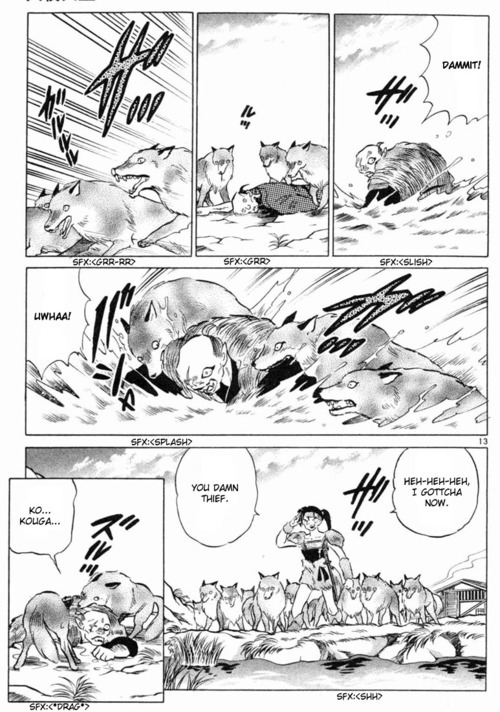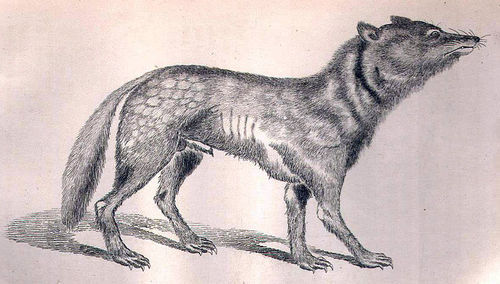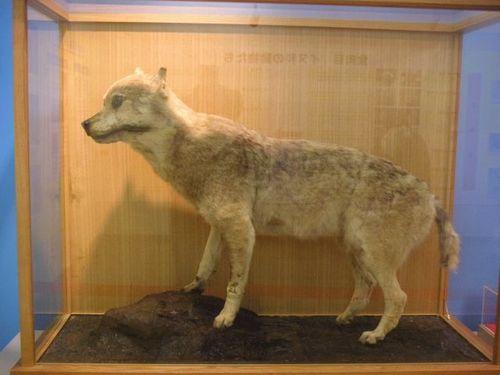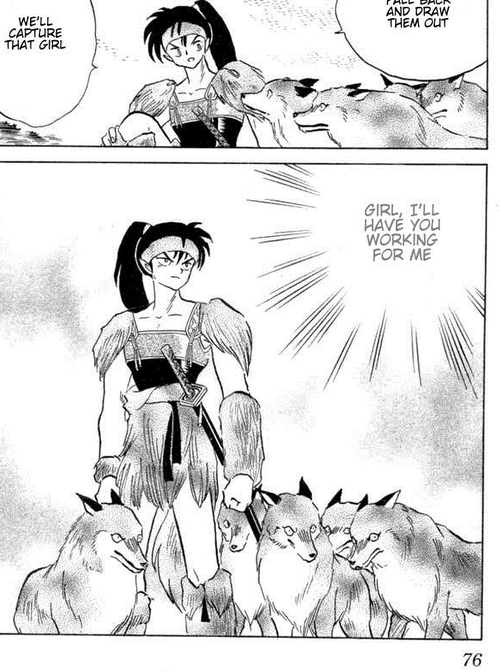META: "Kōga’s Lost Wolves"
Dec. 4th, 2018 06:39 pmSUMMARY: A nonfiction article discussing both the "Wolf Yōkai" of Inuyasha canon, and the place of the wolf in the real-world culture, history and ecology of Japan...including the identification, and extinction (sadface!), of the wolf species that Kōga and his group are most likely based on.
Originally posted in November of 2014 as "Kōga’s Lost Wolves: Part 1", on the tumblr blog version of Inu-Fiction; cross-posted here and to AO3 for archival purposes. Original images described, and original sources given at the end of the article.
INTRODUCTION:
This article was originally written by me for the "Inuvember" event in November of 2014 - as ""Kōga’s Lost Wolves: Part 1" - for the original Inu-Fiction blog on tumblr. Its original URL was: http://inu-fiction.tumblr.com/post/103579398126/k%C5%8Dgas-lost-wolves-part-1
It is being posted here and on AO3 for accessibility and archival purposes, because even though I have yet (as of this cross-post) to ever do a followup, I did work quite hard on this thing originally and tumblr is...worryingly untrustworthy at this point? (Look, I'm a fandom not-quite-old who lost content when GeoCities went Dodo on us, I'm not about to have that happen again).
Sources are discussed/linked at the end of the article.
ARCHIVING NOTES:
The original text, including its original formatting/external links to informational sources, has been preserved as much as possible, but, minor revisions/additions have been made to: 1.) reflect the fact that among other things, I never actually did a followup on this "Part 1", and 2.) describe the images for those who cannot view them or in case the images get borked somehow.
Regarding the spellings of Japanese words, the Style Guide of Inu-Fiction at the time included the use of accented letters instead of additional ones to mark long vowels from Japanese, particularly the long "o" sound that is romanized in many other sources as "ou", but also the long "u" that is sometimes rendered "uu"; hence, you will see the spelling "Kōga" instead of "Koga" or "Kouga", and "Yōkai" instead of "Yokai" or "Youkai", and place names rendered as, say, "Honshū" as opposed to "Honshu" or "Honshuu". This element has been retained in this posting - even in the newly-added Image Descriptions - for consistency's sake.
Please note that at current, the images still point to ones kept on tumblr's servers; I'm working on an alternative to that but in the meantime, the images are described below them.
ARTICLE:
Everyone who's read enough chapters or seen enough episodes of Inuyasha has come across Kōga the wolf yōkai, and his "tribe" of wolves and/or other wolf yōkai. What most people probably miss is the sad subtext tied to his wolves:
They're a dying breed.
In fact, by Kagome's time...they are dead.
Or at least, the species of Japanese wolf that seems to make up the non-humanoid-form-taking members of Kōga's tribe is currently declared extinct, and has been for over a century.
There have been only two species of Japanese wolves: the Hokkaidō Wolf (the larger wolf, found predominantly on the island of Hokkaidō), and the Honshū wolf (found primarily on the Kyūshū, Shikoku, and Honshū islands). Both of these species were once revered as kami, nature spirits, protectors of rice fields and travelers. Both species are now thought, and have been thought for some time, to be completely extinct.
But before I get into the sad history of an extinct species, you're probably wondering how it is I'm so sure that that is the right species.
Well, it's for three reasons: 1.) the timing is correct, 2.) the location is correct, and most importantly, 3.) the morphology is correct.
Timing
The Honshū Wolf went extinct in 1905, and wasn't severely threatened as a species until the introduction of the rabies virus to Japan in 1732. As Hakagure Productions notes, the series' feudal portion is basically set around the middle of the 16th century, give or take, so there was plenty of time during the late Sengoku era in which the series' feudal portions are set, for the Honshū Wolves to still be roaming around.
Location
The timeframe of the "modern" portions of the series is nebulous–some vaguely-defined always-current time between 1995 and the early 2000s–but the location isn't nebulous at all: it's Tokyo, the modern-day capitol of Japan.
The feudal-era portions of the series are set in the same location...only several centuries earlier. Tokyo before it was Tokyo, before it was even a major city.
We know this, because leaving aside the fact that the Bone Eater's Well and the Goshinboku (God-Tree/Sacred Tree) each exist both near Kaede's village and on the Higurashi shrine grounds (which again, are in modern-day Tokyo)...the Ryūkotsusei arc even features Miroku mentioning the "plains of Musashi".
Musashi was the name of the prefecture containing the city of Edo, which was later renamed to–yep!–Tokyo.
Tokyo–or rather, in this case Musashi–was in the range not of the Hokkaidō Wolf, but the Honshū Wolf. Hokkaidō is its own island. It has its own ecology, and back in the day, its own wolf.
So, really, just based on location it should be Honshū wolves. That's the best point to be made. However, it's not the final point.
Morphology
The final proof that Kōga's wolves are Honshū Wolves, is that Kōga's wolves look like Honshū Wolves. They look a heckuva lot like them, even through the typical layers of caricature that come from them being in a Takahashi manga rather than a natural philosophy treatise.
Here's a page full 'o Kōga's wolves from the manga:

[Image Description: A fan-translated page from the original Inuyasha manga, featuring several panels with one or more of the wolves attacking some poor unfortunate dude who was foolish enough to steal from Kōga, and a bottom-right panel with a wide shot of a smirking Kōga accompanied by a large pack of wolves]
Now look at this antique print of a Honshū Wolf:

[Image Description: An antique, public-domain greyscale rendering of a male Honshū wolf, Canis lupus hodophilax, originating from The Chrysanthemum, A Monthly Magazine for Japan and the Far East, Volume I and II, 1881-2, Yokohama. It looks faintly shell-shocked and a bit scraggly, with ribs clearly showing on the side facing the viewer]
Though this print is obviously of a much less well-fed wolf than the ones from Kōga's tribe (seriously, you can see the poor thing's ribs a mile away!), the similarities are pretty striking.
I want you to notice a few things in particular: the bushy tail (if this specimen in the print weren't obviously starving, I suspect the base of the tail would be as bushy as the rest of it); the pointy snout; the petite ears. Kōga's wolves also have quite round, small eyes (so round they look a bit wild), and pretty much have what looks like black lip and eyeliner; the eyes alone are strikingly similar between the two drawings, but also, check out this awkward taxidermied specimen from the Ueno Zoo:

[Image Description: a modern color photo of a taxidermy specimen of a Honshū wolf inside of a glass-walled case belonging to the displays in the Ueno Zoo in Japan (photo credit/sourcing given in closing of article). It looks like it has Seen What Cannot Be Unseen, but its markings and coloration are clearly visible, with black coloration around the eye and mouth, a dark-colored nose, and and light, cream-and-tawny-colored fur elsewhere on its body]
OMG IT HAS THE SAME LIP AND EYELINER MARKINGS
Those cute little haunches also look pretty similar to Takahashi's drawing, notice.
And speaking of little...the Honshū wolf could hardly be called large; it was really the size of a normal, perhaps medium-sized dog, literally the smallest known wolf species.
Notice something about the images of Kōga's wolves? Go on. Scroll back up and look; I'll wait.
Need a hint? Compare the size of Kōga (who is, well, not small by Japanese standards but very much a plausible "human" size)...to his wolves. They're small! They barely come close to his hip in that scene, and that's when he's leaning forward.
In fact, check out these panels from a bit later in the manga:

[Image Description: a translated page from the Inuyasha manga featuring Kōga and multiple wolves. Kōga is standing in the final panel, allowing the viewer to see how tall he is in respect to the wolves. He Tol; they Smol.]
Not only are the snout shapes even more strikingly similar in these panels, when he and they are all standing straight and are all on a surface that appears to be relatively level (as opposed to the lumpy ground in the previous example page)... these wolves only come to Kōga's mid-thigh.
Again, one of the hallmarks of the Honshū Wolf was its small size compared to other wolves; these appear to fit the bill as perfectly as you could expect.
Unfortunately, if you will recall the introduction to this article...that isn't necessarily good news. Not for Kōga's tribe, at any rate.
Because if these are Honshū wolves, then they are either completely extinct by the time his darling little Kagome is even born...or there are so few of them, and they are so justifiably afraid of humans, that they're in such deep hiding as to be mistaken for extinct. Which is definitely food for thought in regards to any fics set later than the 1800s, in particular, when the species appears to have been on its last legs.
The question then, for us fans and fic-writers setting stories in those periods, is: is the species truly extinct, or just in hiding?
Well, it's not impossible for it to be the latter, as Japanese folklore actually holds that they are magically gifted in hiding, and for that reason some modern Japanese people in the area don't actually believe them to be extinct. But it's also very possible they really are extinct or nearly-extinct. If Kōga's tribe's little accompanying pack still exists, it's very well-hidden. And if it doesn't...what does that mean for Kōga and his buddies?
This is something I hope to examine in the sequel article to this, as well as an additional set of questions, and their implications:
- What is the actual relationship between the normal-looking wolves that Kōga leads, and the wolf yōkai like himself?
- How do these packs and/or these tribes, actually function socially?
- And most importantly: what the hell are the wolf yōkai, and where do they come from? How does the lore of Takahashi's wolf yōkai relate to Japanese folklore about wolves?
Hopefully I have provided some food for thought with this article, and will do so with its followup. Thanks for reading!
Sources:
- Wikipedia: Honshū wolf (last version accessed: edit from 15 August 2014 at 14:59)
- SciLogs: Lost Wolves of Japan (published 27 September 2010, author Anne-Marie Hodge) - Though it renders the name of the Honshū wolf somewhat oddly, this entry contains valuable information cited here as well as providing a larger historical and scientific context for the extinction of both types of Japanese wolf.
- Hagakure Productions: "Does Anybody Really Know What Jidai It Is?" ( 4 March 2008 update, author Scribe Figaro)
- Inuyasha Fanon: "What Year Does the Series Take Place?" (published November 9, 2013, author inu-fanon, aka Inu-Papa, Patches, fast-moon ).
- Hokkaido Travel Guide from Japan Guide
- "On the Extinction of the Japanese Wolf" (author John Knight, International Institute for Asian Studies, Leiden, originally published in Asian Folklore Studies, v56 n1 (1997), pp. 129-159; text at link above hosted by "Wolfology", JSTOR link to copy of the original paper here, for those who have an account). - Contains more detailed cultural context for wolf folklore in Japan. Very cool stuff.
Images:
- Canis lupus hodophilax from The Chrysanthemum, A Monthly Magazine for Japan and the Far East, Volume I and II, 1881-2, Yokohama. Image copy courtesy of Wikipedia, copied and edited (by Wikipedia users) from public domain image.
- Photo of Honshū wolf taxidermy at the Ueno Zoo courtesy of Japanese Wikipedia user 利用者:Katuuya; used in accordance with the image's Creative Commons Attribution-Share Alike 3.0 Unported license. Found via English-language Wikipedia.
- The Inuyasha manga images are of course, copyright of Rumiko Takahashi and her publishers, and are used here in small amounts and purely for educational purposes. Chapters that were sampled are, in order: Chapter 130 (狼 , "Wolves") and Chapter 132 (鋼牙,"Kōga"). If you need to check against the volume numbers or see the wider context for these, you can find them listed under Volume 14, at this Wikipedia page or this one, both of which list the Japanese and English-language books' ISBNs.
.